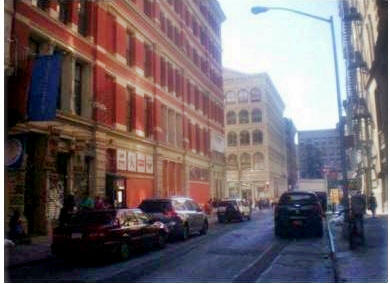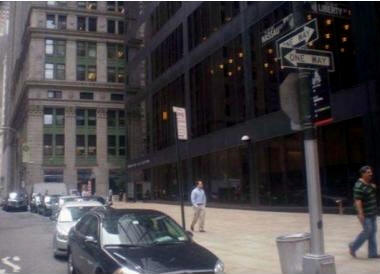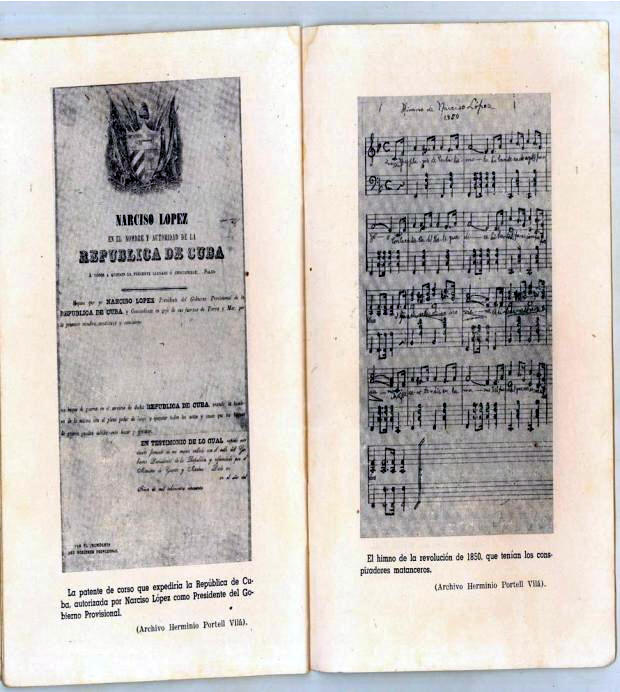|
Image
taken from Cubarte, website of the Ministry of Culture of the Republic
of Cuba, on 26 April 2010. “Tomb of the seamstress of the Cuban Flag
found”, in Prensa Latina (Matanzas), News section, at
www.cubarte.cult. cu
The
history of the Americas has many examples of cultures, especially
Cuba’s, that have woven new identities, as with the United States, and
continuing in the 19th century and into the 20th.
It is no
surprise that the Cuban flag was conceived on U.S. soil in 1849 and from
there went to Cuba. These pages are dedicated to unraveling those
details, and take as their main sources (among others) the first
historian of Havana, Emilio Roig de Leuchsenring (1889–1964)
and, basically, his Banderas oficiales y revolucionarias de Cuba
[Official and Revolutionary Flags of Cuba] (Colección Histórica Cubana y
Americana 7, Municipio de La Habana, 1950, 143 pages), “Homenaje del
municipio de La Habanaa nuestra enseña nacional en su primer
centenario, 1850–19 de Mayo de 1950” [“Tribute from the municipality of
Havana to our nation’s flag in its centenary, 1850 to 19 May 1950”]),
and his Cuba y los Estados Unidos de América: Historia documentada de
la actitud disímil del Estado y el pueblo norteamericanos en relación
con la independencia de Cuba, 1805–1898 [Cuba and the United States of
America: The Documented History of the Dissimilar Attitudes of the
North American Government and its People Regarding the Independence
of Cuba, 1805–1898] (“Publicaciones de la Sociedad Cubana de
Estudios Históricos e Internacionales”, La Habana, 1949; 279 pages, 21
cm).
Other
sources were also very revealing, especially in the José Marti National
Library and the Ruben Martinez Villena Central Library at the
University of Havana: Emeterio Santiago Santovenia y Echaide
(1899–1968), in his article on La bandera de Narciso López en el Senado
de Cuba [The Flag of Narciso López in the Senate of Cuba] (Havana,
Senate Official Editions, 1945, 47 pages, 18 cm), and above all,
Dr. Herminio Portell Vilá (born 1901, Professor of American
History at the University of Havana and of Cuban Military History at the
War College, considered the definitive biographer of Narciso López, to
whom we owe the Cuban flag), with his Breve biografía de Narciso López
[Brief Biography of Narciso López] (Sociedad Colombista Panamericana,
1950) and Narciso López y su época [Narciso López and his Times]
(Compañía Editora de Libros y Folletos, Havana, 1952), as well as
Ezequiel García‐Enseñat’s
Estudio de las banderas de Cuba [Study of the Flags of Cuba].
Although
Roig’s history goes back to when Spain claimed Cuba under the
flag of Castile (allegedly purple but more likely crimson), of
particular interest is his inquiry into the flag used when Cuba joined
the roll of nations in 1902 after its independence in 1898. That flag
had been conceived by Narciso López, a Venezuelan born in Caracas on 29
October 1797: we note that it was created and developed during the era
in which Latin American independence flourished, and that among the
dreams of López’s countryman, the liberator Simón Bolívar, Cuba
was never forgotten.
Son of an
established merchant and landowner in Valencia and Caracas, and of a
lady from an old and distinguished Caracas family, López received
in Caracas an education equal to or greater than that of many
leaders of the Venezuelan independence, although not as much as that of
Bolívar, who had the best private tutors. López studied at the
Wantosten Academy of Mathematics, created by the country’s supreme
governing board. When its students, after Venezuela’s declaration
of independence of on 5 July 1811, petitioned the military commander of
Caracas for military training in service of the country’s independence
struggle, among the signatories was 13‐year‐old
Narciso López. He was not called, presumably because of his young age
(Portell, 1952:4–5).
By the
time López was 16, he was trying to join the fight against Spanish
colonialism. Despite his abilities, he was not accepted by the
liberators (perhaps because of a strongly anti‐independence
uncle, which led the patriots to distrust him), still he felt
the call to fight for Venezuelan independence. According to Portell
(1952:5–6), López was among the besiegers (“but as a spectator”) when
Bolívar besieged Puerto Cabello, in September 1813, and shortly
afterwards along with Bolívar, he watched the Spanish reinforcements
arrive, and in September he was part of the triumph of General José
Félix Ribas at La Guaira (“but without fighting”)… without actually
joining the independence fighters. He finally acceded to the insistence
of his uncle and became a Spanish soldier—the same day that
Simón Bolívar was defeated in the disaster of La Puerta, which
seemed to be the end of the independence movement, by Boves and his
rangers (who, in taking Valencia, killed López’s father).
López came under the protection of one of the most unscrupulous but
brave lieutenants of Boves, who exercised an unfortunate influence on
him. He rose in the Spanish army without wanting to spill the blood of
Venezuelans, wearing he would call “that brilliant but ignominious
livery”.
In 1819
López was a lieutenant colonel and distinguished himself in
the Battle of Carabobo, which led to his promotion to
colonel. He was governor of Maracaibo (the last Spanish
stronghold) and second in command of the Spanish army when,
after the triumph of the Venezuelan Independence in 1823, it
evacuated to Santiago de Cuba. At that time Cuba was shaken by the
Conspiracy of the Suns and Rays of Bolívar (a Masonic group
plotting Cuban independence) and the possible invasion by Paez under
orders of the liberator Bolívar, while the annexation movement was
beginning in Cuba. Some of his countrymen would later join him in his
revolutionary efforts.
López
married the sister of a Havana man who would become Count of Pozos
Dulces. When he appeared with them in a trial regarding the
landholdings of the family in El Vedado, showing contempt of court by
refusing to appear in full uniform of a colonel of Hussars of Fernando
VII, this attracted the attention of Cubans seeking a gifted and
resolute military leader, in spite of his service to Spain and its
reprehensible representatives. But in the first months of 1827 he was
sent to Spain without a command, the Spanish fearing that he was
sympathizing with the Cubans (such as the conspiracy of the Black
Eagle), as well as with other officers defeated in America, who were
called Ayacuchos after the great defeat of Spain in Peru. He did in
fact connect with the Ayacuchos and Creole residents in Cuba, joining
the Club de La Habana (Club of Havana).
At the
beginning of the Carlist war in Spain, López was recalled to active duty
and would save the life of his general Jerónimo Valdes, who assigned him
to the international commission to regulate the Carlist War and
eliminate the atrocities by both sides, and won the praise of his
English colleagues. He was liberal and progressive, and came to be
among the most influential reformers, winning high military degrees and
defeating Colonel Carlos O’Donnell, earning the undying hatred of
his relative, Leopold O’Donnell. When in 1836 the Cuban
deputies were expelled from the Spanish Court, he called on
all Creole officials to resign en masse and promoted protests
by the Club de La Habana, made personal entreaties to the
Spanish legislators, and obtained the support of General Valdes,
although in vain. He was associated with in the conspiracy in Spain of
the Triangular Chain and Suns of Freedom (based in Havana but with
branches in Spain) and was betrayed; his ideological evolution toward
the revolution is explained by living within the monarchy to its service
and meet its ills from within.
In Spain,
López (first in Barcelona, then Madrid) contributed significantly to the
downfall of the regency of Maria Cristina (1840) and the establishment
of the regency of Espartero, which was considered a victory for progress
(Portell, 1950). It was López who, as military governor of the plaza,
received Espartero on his arrival at the Court of Madrid, and
his liberal friends were placed in positions of power ... until
Espartero fell. Meanwhile, he had sent to Cuba for his elderly mother
and his niece, Mrs. Rosa Salicrup de Sanchez; another relative of his
(Manuel Muñoz de Castro) was the consul of Venezuela in Havana.
Cuba had
rebelled against the “scandalous closure of the Courts to the
representatives of Cuba and Puerto Rico” and wanted to “free both
islands from the clutches of his equally ruthless greedy stepmother”
(Roig, 1950) and the United States tried to buy Cuba from
Spain. And when the new governor of Cuba, Leopoldo O’Donnell, the
mortal enemy of López, arrived in Havana in March 1843, he stripped
López of his high office and forced him to leave the military, sowing
the seeds of rebellion on already fertile ground. López
would be involved in the Conspiracy of La Mina de la Rosa
Cubana (1847, named after one of the wells of the San Fernanda
mining reserve in Manicaragua) in Las Villas.
Three
flag designs for Cuba appeared in this era. The first, according to a
letter from Cirilo Villaverde to the director of La Revolución de Cuba
(15 February 1873), used the Republican colors in horizontal stripes:
blue, white, and red, in a distant imitation of the flag of Colombia.
The second, according to José Sanchez Iznaga on 10 July, had
a large star at the hoist from which ran three equal stripes of
blue‐white‐blue;
a variant of this flag has a red star at hoist end of the central white
stripe, and is shown this way on the shield used on the proclamations of
Narciso López in 1850 and described by Dr. Portell in his Historia de
Cuba en sus relaciones con los Estados Unidos y España [History of Cuba
in its Relations with the United States and Spain] (1938). The third,
designed by members of the Club de La Habana and published by Enrique
Gay‐Calbó
(born in Holguín, 1889) in his La bandera, el escudo y el himno [The
Flag, the Coat of Arms, and the Anthem] (Havana, 1945), had a blue
rectangle at the hoist, with an eight‐pointed
white star and three wide red stripes separated by two narrow white
stripes (according to the design in the files of Dr. Portell).
Meanwhile, López met with the United States consul in Havana, Robert B.
Campbell, through whom he learned that in Havana there was another
conspiracy—but this one annexationist— headed by landowners and rich
Creoles such of those in the Club de La Habana. When this plot failed,
López managed to escape disguised as a sailor on the Neptune, sailing
out of Matanzas bound for Newport, Rhode Island, in the United States,
while in Cuba, the Spanish government in 1849 sentenced him in
absentia to death by firing squad. Cuban émigrés had different
opinions—some were against annexation, including those who rejected U.S.
support, and some were for annexation, both those who preferred the
slave‐owning
South and those who favored the democracy of the North. People in
United States also differed in their views and goals in weaning Cuba
from Spain—Southerners wanted to turn Cuba into another slave state and
were applauded by Cuban slave‐owners,
while Northerners wanted to annex Cuba and free its slaves, and
introduce other liberties. These same differences, just fifteen years
later, would lead to the United States into a civil war to
abolish slavery and establish a new order in the northern
colossus, which would also defeat the annexation aspirations of the
Cuban slaveholders. But in 1850, this future was still unknown.
At that
time a traditional and healthy relationship had long existed
between the peoples of Cuba and the United States, from the very
beginnings of both nationalities. Not surprisingly, among North
Americans who have risked their lives for the freedom of Cuba, one of
the most important fighters was Henry Reeves, called “the Little
Englishman”. In the same way, many Cubans have fought for the just
causes of the people of the U.S., among then, the Havana‐born
José Agustín Quintero y Woodville (1829–1885), who was imprisoned in
1848 (with Villaverde and others) and sentenced to death, but escaped to
the United States to fight in the Civil War with the republican North
against the slave South, and then to fight with Juarez in Mexico. It is
no coincidence that in Portell’s vast work can be found, for example,
the biography of Reeves and Los Cubanos y la Independencia de EUA
[Cubans and the Independence of the United States], (1946).
Furthermore, the United States has traditionally long been a
refuge for persecuted and disgruntled Cubans, and the influences
between the two peoples are many and deeper over time; Cuba’s flag flies
atop such influences.
Roig
quotes Gerardo Castellanos (p. 139), who analyzed the efforts of López
to get all possible support (even that of annexationists) for his
campaigns in Cuba; he led U.S. Southerners to believe that Cuba
would continue slavery, and at the same time he flattered the
Northerners about their freedoms, attracting politicians and
businessmen, offering to pay veterans (including Robert E. Lee,
who would become the Confederacy’s best‐known
general, and Jefferson Davis, who would become its president) to
participate. For this he would be widely criticized as an
annexationist by Cuban independence leaders; Dr. Portell
counters this by pointing to the lone star (for full independence) on
the flag. However, even in 1888 Manuel de la Cruz (1861–1896), of
Havana, accused López of sympathizing with annexation, which led to a
famous controversy with Cirilo Villaverde.
Upon
arriving in the United States, López joined with others seeking Cuban
independence to create the Junta Promovedora de los Intereses Políticos
de Cuba [Board for the Promotion of the Political Interests of Cuba, or
the Cuban Junta of the U.S.], a splinter group opposed to the
annexation goals of Cristóbal Madan, and made contact with the
plotters of the Club de La Habana, which used a very different flag
from that which López would design. The propaganda organs of the Cuban
Junta of the U.S. were the newspapers La Verdad [The Truth] (New York),
and La Patria [The Nation] and El Independiente [The
Independent] (New Orleans). They negotiated with politicians and other
figures of influence, sought official government support, began
recruiting, and set up a camp on Cat Island (in the Gulf of Pascagoula,
in the Bahamas).
There
they managed in early 1849 to gather some 200 men for an expedition to
Cuba. But the sympathy of many sincere North Americans supporting a free
Cuba was not matched by the federal government, which had other
interests; the expedition to Cuba was denounced by the Spanish
governor of the island, the Count of Alcoy, and the
government in Washington demanded that López immediately disband the
expedition. Similarly, in 1849 the government under President Taylor
would demand that he disband his next expedition, organized in
Isla Redonda (Round Island).
One of
General López’s fellow strugglers in exile, the eminent novelist from
Pinar del Rio, Cirilo Villaverde (1812–1894), would relate in 1873 on
page 3 (backside) of his handwritten notebook Reseña biográfica del
general Narciso López [Biographical Overview of General Narciso López]
(held by Dr. Portell, and reproduced by Gay‐Calbó
as an appendix to his cited work), that today’s Cuban flag was
designed by López in 1849, while he lived at the home of Mrs. Clara
Lewis, 39 Howard Street, near the corner of Broadway in New
York. From that house he frequently visited the home of the patriot
from Matanzas, Miguel Teurbe Tolón y de la Guardia (1820–1857), whom
López asked to design the national arms for an independent
Cuba. Beginning in 1849 proclamations and bonds bear those arms, and
they were seen in New York, for example in a tobacconists’ shop
(Portell, 1952:138). These are Cuba’s primary national symbols,
whose roots, as is logical and obvious, are inextricably linked. In
this revolutionary atmosphere it was no accident that there would even
exist a “hymn of the revolution” among the conspirators of Matanzas,
and a code with which López would communicate with other
revolutionaries underground in Cuba (Portell, 1950:33 and 35)(see
Appendices 2 & 3).
|












